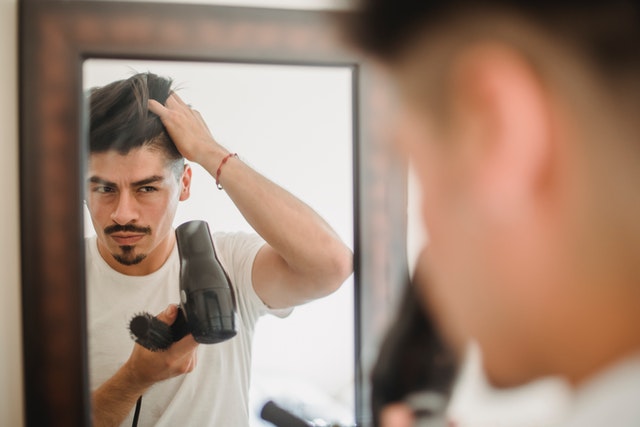Hair loss is a common aesthetic and dermatological condition that’s all too familiar to many men, with causes that range from underlying genetics to medical conditions, the effects of prolonged stress, and even our diet. Androgenetic alopecia, the medical name for male pattern baldness, is the most common form of hair loss in men. In fact, it affects a staggering 30-50% of men before the age of 50.(1) Regardless of how we lose our hair, these changes in our appearance can affect how we see ourselves. And as we age, we may feel less connected with our masculinity and lose confidence. However, like so many cosmetic issues, there are effective in-office medical and surgical solutions available from the experts!
Finding the right hair doctor can be challenging, but fortunately, Houston’s Dr. Goran Jezic has the knowledge and experience to take your hair transplantation experience to the next level. Taking advantage of innovations in Follicular Unit Extraction (FUE) with NeoGraft or ATERA, his number one goal has always been to provide practical, effective solutions for hair loss. He was an early adopter of the NeoGraft and ATERA technologies; two leading hair restoration systems that meticulously extract the most viable follicles for transplantation. To schedule a consultation with Dr. Jezic to find the right treatment for your needs, please fill out our online form, or call us at (713) 864-2300.
Androgenetic Hair Loss
Androgenetic alopecia in men develops in a distinct pattern, affecting the hair at the temples, crown, and mid-frontal scalp above the forehead.(1) In these cases, hormones disrupt the natural hair cycle, which causes progressive thinning.
The Hair Cycle
All hair on our bodies, including the hair on our scalp, goes through four phases of growth and renewal.
- Anagen (growth phase)
- Catagen (transition phase)
- Telogen (resting phase)
- Exogen (shedding phase)
The average length of the anagen phase in the hair cycle is two to six years. An enzyme called 5-alpha-reductase inhabits hair follicles, as well as the glands that keep them healthy. This enzyme converts the hormone testosterone into dihydrotestosterone which can shorten the growth phase of the hair follicle, causing it to shed at a faster rate. So, although a combination of factors contributes to androgenetic alopecia, high 5-alpha-reductase and dihydrotestosterone levels are key characteristics in patients with male pattern baldness.(2)
Other Reasons for Hair Loss
Unfortunately, many diseases can cause hair loss. Tinea capitis, commonly known as ringworm, is a fungal scalp condition that can cause circular patches of hair loss. Other skin conditions such as atopic dermatitis and psoriasis can cause a negative impact on the scalp’s microenvironment.(3) Another more common reason patients see a loss of hair is due to an overactive thyroid (hyperthyroidism) or an underactive thyroid (hypothyroidism). In such cases, patients and caregivers should address the thyroid imbalance before considering their options for hair restoration. Autoimmune diseases such as lichen planus and lichen planopilaris, advanced forms of Alopecia Areata, can cause hair loss when the overactive immune system begins to attack the hair follicles. Patients with lupus not only lose hair but are unable to regrow it because of the resulting scarring. Hair may also fall out in clumps as a result of an autoimmune disorder known as alopecia areata.
Nutrition
Dietary factors may lead to hair loss. For example, deficiencies in iron can lead to hair loss, as well as excessive intake of selenium, vitamin A and vitamin E.(4) Similarly, dangerous trends such as crash dieting and rigorous caloric restriction can cause hair loss due to an inadequate supply of energy to the hair follicle.
Stress
Emotional and environmental stressors can actually weaken the hair follicles and lead to hair thinning. Unfortunately, hair loss can be both a cause and a symptom of stress.
Medical Treatment
Hair loss can sometimes occur as a response to the stress of major surgery. This type of hair loss generally goes away with time. Hair thinning may be a side effect of some medications and can accompany chemotherapy. In these cases, hair generally regrows following the end of treatment.
About Hair Restoration
Many patients choose FUE for their hair transplant in Houston, Texas, because:
- It’s a minimally invasive procedure
- There are no scalpels or stitches required
- Of its long term cost-effectiveness
- It offers natural-looking results
- There’s a quick recovery period
- There’s reduced post-procedure scarring
- No linear scar in the donor area.
FUE vs. FUT
An alternative to FUE is Follicular Unit Transplantation (FUT), or “The Strip Procedure” which removes a strip of skin from the back of the scalp which is then transplanted into the thinning and balding areas.(5) This more invasive technique can be painful, and can leave noticeable linear scars.
On the other hand, FUE involves harvesting smaller groups of hairs, known as follicular units, or simply grafts, from a donor area – usually another part of the scalp – with a specialized punch tool.
FUE Treatment Options
Dr. Jezic only uses two FUE technologies – NeoGraft and ATERA which he finds far more robust compared to robotic hair restoration or robotic hair transplants. These technologies enable him and the team to perform MEGA Sessions up to 4,000 grafts per session.
NeoGraft
Neograft is a minimally-invasive hair restoration system that leaves no linear scar. It’s an old work horse, automated, making it a lot easier for the surgeon performing the procedure to concentrate on providing effective aesthetic results. This advanced technology uses an articulated arm and specialized handpieces for consistent, accurate clinical results.
ATERA
The ATERA FUE system provides calculated graft harvesting, allowing for the optimal distance between grafts. It enables surgeons to punch follicular units in three sizes; 0.8mm, 0.95mm, and 1.05mm. It also utilizes patented graft lubrication technology and saline collection system to preserve each follicular unit until it is implanted. Each system can accurately harvest grafts before manual placement. Both NeoGraft and ATERA use enhanced technology to collect, sort, and store each graft before transplantation. The patented tools and software used in FUE allow for greater accuracy, enabling your surgeon to identify and precisely harvest the most healthy hair for transplantation!
Candidates for FUE
Ideal candidates for a hair transplant older than 25 with an established pattern of androgenetic alopecia. Medical issues such as diabetes, high blood pressure, or conditions that interfere with blood clotting should be well-controlled.
The best candidates for FUE:
- Generally plan on wearing their hair short
- Seek a minimally invasive surgical procedure
- Have thinning hair at the crown or front of the scalp
- Have good quality, healthy hair in the donor area
- Have sufficiently thick hair in the donor area.
If someone is not a candidate, Dr. Jezic will suggest non-surgical, topical, collagen induction therapy, and/or product alternatives.
Personal Consultation
During your initial hair restoration consultation, Dr. Jezic will discuss your medical history, examine your scalp, and outline the best approach for treatment. He will also discuss the feasibility of alternative restorative measures, and may suggest a combination of medication and FUE to gain the best aesthetic results. He will assess your areas of hair loss and identify the best area of your scalp from which to harvest follicular units. Dr. Jezic will carefully guide you through the process from start to finish, so you know exactly what to expect. This will include giving you detailed information on preparation, risks, recovery, and the probable outcomes of your hair transplant procedure. He will be happy to answer any questions you may have, so please feel free to ask!
Results of FUE
Since FUE eliminates the need for long scalp incisions, our patients enjoy a speedier recovery than other hair transplantation methods. In fact, most patients can return to work the very next day!
Dr. Jezic provides personalized post-operative instructions, along with some tips and tricks to ensure your recovery runs smoothly. Once you’ve healed completely, you can enjoy your new hair for a lifetime. With a fuller head of hair, you can enjoy renewed confidence and a younger-looking, healthier appearance!
Cost of FUE in Houston, TX
The cost of a hair restoration treatment varies depending on whether NeoGraft or ATERA is used, the number of grafts harvested, and if any additional remedies, such as topical medications and injections such as collagen induction therapy (CIT), are required. We will discuss your circumstances and unique pricing details during your consultation.
Hair transplants using the Neograft method start at as little as $4.50 per graft, which is half as much as other clinics, many of whom will charge between $6.00 and $11.00 per graft! Since we perform volume, we are able to pass on the cost savings to our esteemed clients.
Please call us at (713) 864-2300, or fill out our online form to schedule your appointment with Dr. Jezic at his Houston office. To learn more about Dr. Jezic’s effective approach to hair restoration, take a look at his other informative blog posts.
FAQ
Is there a long recovery process after a hair transplant?
The scalp heals remarkably quickly. On average, patients who have undergone FUE, such as NeoGraft or ATERA can expect relatively rapid healing, often within seven days of their treatment. The final results of FUE are usually apparent after around six to nine months. If you diligently follow you pre and post-op instructions, your healing would be smooth sailing.
Is donor hair supposed to fall out after FUE?
Yes! After the initial healing phase, the donor hair will shed. But, before it does so, it stimulates the hair follicle to produce its own hair. Your surgeon will give you details about what to expect during your recovery period, and give you a rough timeline of what to expect, and when.
What hair products can I use after FUE?
After around two weeks, most patients will be able to use their regular hair products. It’s advisable to stay away from heavily scented products, and opt for mild, scent-free, hypoallergenic products. It’s always best to check with your provider to make sure the product you want to use on your hair won’t negatively affect your results.
References
- Cranwell, W., & Sinclair, R. (2016, February 29). Male Androgenetic Alopecia. Nih.gov; MDText.com, Inc. https://www.ncbi.nlm.nih.gov/books/NBK278957/
- Garg, A., & Garg, S. (2018). Donor harvesting: Follicular unit excision. Journal of Cutaneous and Aesthetic Surgery, 11(4), 195. https://www.ncbi.nlm.nih.gov/pmc/articles/PMC6371717/
- Trueb, R., Henry, J., Davis, M., & Schwartz, J. (2018). Scalp condition impacts hair growth and retention via oxidative stress. International Journal of Trichology, 10(6), 262. https://doi.org/10.4103/ijt.ijt_57_18
- Guo, E. L., & Katta, R. (2017). Diet and hair loss: effects of nutrient deficiency and supplement use. Dermatology Practical & Conceptual, 7(1), 1–10. https://doi.org/10.5826/dpc.0701a01
- Zito, P. M., & Raggio, B. S. (2021). Hair Transplantation. PubMed; StatPearls Publishing. https://www.ncbi.nlm.nih.gov/books/NBK547740/




